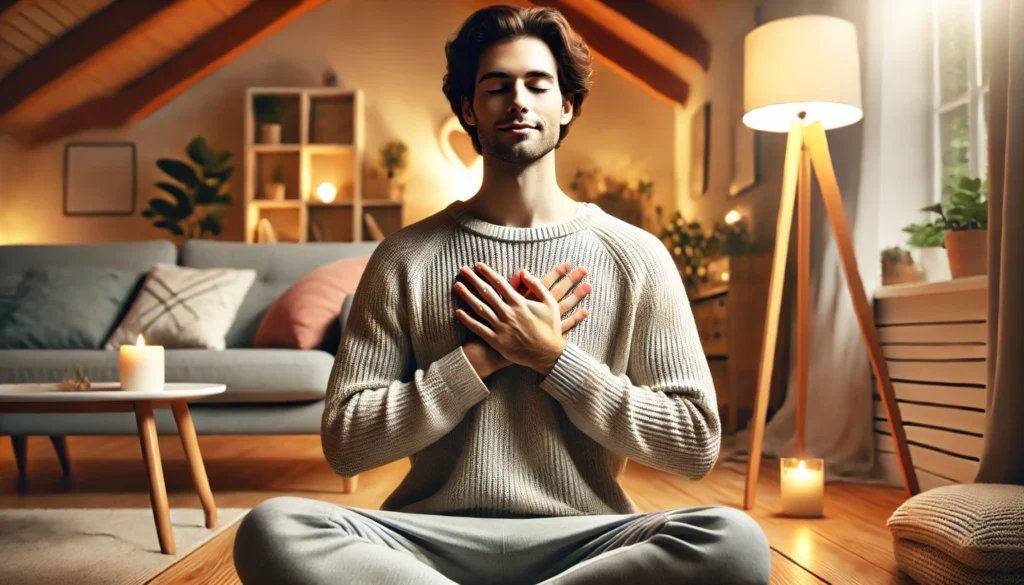In our fast-paced, constantly connected world, anxiety has become an unwelcome companion for many. While there are numerous strategies to tackle anxiety, meditation stands out as a powerful tool to calm the mind and ease the symptoms of anxiety. In this article, we will delve into quick meditation techniques designed specifically to alleviate anxiety, providing a sanctuary of peace and clarity amidst the chaos.
You may also like: Natural Supplements for Effective Anxiety Relief

Understanding Anxiety and Its Effects
Anxiety is more than just an occasional worry or fear. It is a pervasive condition that can interfere with daily activities, relationships, and overall well-being. Anxiety disorders are among the most common mental health issues, affecting millions worldwide. From generalized anxiety disorder to panic attacks, the symptoms can vary widely, but the underlying feeling is often the same: a debilitating sense of unease and tension.
The Psychological Impact of Anxiety
Anxiety can manifest in numerous ways, impacting both mental and physical health. Individuals often experience racing thoughts, excessive worry, and an inability to concentrate, which can lead to decreased productivity and a diminished quality of life. Over time, these mental symptoms can evolve into chronic stress and contribute to burnout, making effective management essential.
The Physical Manifestations of Anxiety
The mind-body connection means that anxiety can also have tangible physical effects. Common symptoms include increased heart rate, muscle tension, and even gastrointestinal issues. These physical manifestations can exacerbate feelings of stress and lead to a vicious cycle of anxiety, where physical symptoms heighten emotional distress and vice versa.
The Societal Implications of Anxiety Disorders
Beyond individual experiences, anxiety disorders have broader societal implications. They contribute to significant economic burdens through healthcare costs and lost productivity. The stigma surrounding mental health issues can also deter individuals from seeking help, emphasizing the need for accessible strategies, like meditation, to alleviate symptoms and promote well-being.
The Science Behind Meditation for Anxiety
Meditation is an ancient practice that has been proven to have profound effects on the mind and body. Scientific research has shown that regular meditation can reduce the symptoms of anxiety by altering the brain’s response to stress. Mindfulness meditation, in particular, encourages a non-judgmental awareness of the present moment, which can help individuals detach from their anxious thoughts and feelings.
Neuroplasticity and Meditation
One of the most remarkable aspects of meditation is its ability to foster neuroplasticity, the brain’s capacity to reorganize itself by forming new neural connections. Regular meditation practice strengthens areas of the brain associated with emotional regulation and decreases activity in the regions linked to anxiety and stress, demonstrating a tangible impact on mental health.
Hormonal Changes Induced by Meditation
Meditation influences the production of key hormones and neurotransmitters. Studies reveal a decrease in cortisol, the primary stress hormone, and an increase in serotonin and dopamine, which are associated with feelings of happiness and pleasure. This hormonal shift not only alleviates anxiety but also promotes a more positive outlook on life.
Meditation and Its Effect on the Autonomic Nervous System
Meditation can also help balance the autonomic nervous system, which regulates involuntary bodily functions. By activating the parasympathetic nervous system, meditation counteracts the fight-or-flight response triggered by anxiety, promoting relaxation and reducing heart rate and blood pressure, contributing to an overall sense of calm.

Quick Meditation Techniques for Anxiety Relief
1. Mindfulness Meditation
Mindfulness meditation is a widely practiced technique that involves focusing your attention on the present moment. It can be as simple as paying attention to your breath, the sensations in your body, or the sounds around you. Here’s a quick guide to practicing mindfulness meditation:
- Setting the Stage for Mindfulness: Find a quiet place where you won’t be disturbed. This could be a corner in your home or a peaceful spot in nature. The key is to create an environment where you feel safe and relaxed.
- Positioning Your Body: Sit comfortably with your back straight, either on a chair or on the floor. This posture helps maintain alertness while encouraging relaxation, allowing you to focus your mind more effectively.
- Beginning the Practice: Close your eyes and take a few deep breaths to relax. Deep breathing signals your body to enter a state of calm and helps center your thoughts on the present moment.
- Focusing on Breath: Focus your attention on your breath, noticing the sensation of the air entering and leaving your nostrils. This simple act can ground you, pulling you away from anxious thoughts and into the present.
- Managing Wandering Thoughts: When your mind wanders, gently bring your focus back to your breath. This is a normal part of meditation; acknowledging stray thoughts without judgment is crucial in building mindfulness.
2. Guided Meditation
Guided meditation is an excellent option for those who find it challenging to meditate on their own. With guided meditation, an instructor leads you through the process, often using visualization techniques to help you relax. Many free guided meditations are available online and can be accessed through meditation apps or websites.
- Choosing the Right Guide: The key is to find a voice and style that resonates with you, allowing you to fully immerse yourself in the experience and let go of anxiety. This connection is vital for making guided meditation an effective practice.
- Incorporating Visualization: Visualization techniques can enhance the meditation experience. Instructors might guide you through imagining calming scenes or scenarios, which can further deepen your relaxation and reduce anxiety.
- Accessibility and Convenience: Guided meditations are widely accessible, with many available for free online. This convenience makes it easy to incorporate into your routine, regardless of your schedule or experience level.
3. Body Scan Meditation
Body scan meditation is a technique that involves mentally scanning your body from head to toe, paying attention to any areas of tension or discomfort. This practice encourages relaxation and helps to bring awareness to the physical manifestations of anxiety.
- Preparing for the Scan: Lie down comfortably on your back with your arms at your sides. Ensure your environment is calm and free from distractions to maximize the benefits of the body scan.
- Beginning the Scan: Close your eyes and take a few deep breaths. This initial step helps you settle into the practice, preparing your mind and body for the relaxation to come.
- Focusing on Body Parts: Begin by focusing your attention on your toes, noticing any sensations or tension. This meticulous attention to each body part encourages a deeper connection with your physical self.
- Progressing Through the Body: Gradually move your focus up through your body, part by part, until you reach the top of your head. This systematic approach ensures you address all areas of tension, promoting holistic relaxation.
- Releasing Tension: Take your time with each area, allowing yourself to relax and release tension. This practice not only alleviates physical discomfort but also reduces anxiety’s grip on your mind.
4. Loving-Kindness Meditation
Loving-kindness meditation, or “metta” meditation, involves silently repeating phrases of goodwill and compassion towards yourself and others. This practice can be particularly helpful in reducing anxiety related to self-criticism and negative self-talk.
- Fostering Self-Compassion: Sit comfortably with your eyes closed. Begin by directing loving-kindness towards yourself, repeating phrases like “May I be happy, may I be healthy, may I be safe.” This practice nurtures self-compassion and counteracts negative self-talk.
- Extending Compassion to Others: Gradually extend these wishes to others, starting with loved ones and eventually encompassing all beings. This expansion of compassion can foster a sense of connection and reduce feelings of isolation often associated with anxiety.
- Experiencing Emotional Benefits: Engaging in loving-kindness meditation can lead to emotional benefits, such as increased empathy and a greater sense of peace. These positive emotions can counterbalance the negativity brought on by anxiety.
- Building Emotional Resilience: By regularly practicing loving-kindness meditation, individuals can build emotional resilience, equipping themselves to handle anxiety-inducing situations with greater ease.

Incorporating Meditation into Your Daily Routine
To experience the full benefits of meditation for anxiety relief, consistency is key. Here are some tips for incorporating meditation into your daily routine:
Starting with Small Steps
Begin with just a few minutes a day and gradually increase the duration as you become more comfortable with the practice. Short, frequent sessions can be more effective than sporadic, lengthy ones, especially for beginners.
Establishing a Routine
Set a regular time to meditate each day. Whether it’s first thing in the morning to set a calm tone for the day or before bed to unwind, consistency helps make meditation a habit, integrating it seamlessly into your lifestyle.
Creating a Dedicated Space
Designate a quiet, comfortable area in your home for meditation, free from distractions. This space should evoke tranquility and allow you to focus entirely on your practice, enhancing its effectiveness.
Practicing Patience
Like any skill, meditation takes time to develop. Be patient with yourself and remember that the journey is just as important as the destination. Progress might be gradual, but perseverance will yield significant benefits over time.
The Future of Meditation for Anxiety Relief
As our understanding of the mind-body connection continues to evolve, meditation is increasingly recognized as a powerful tool for mental health. Future research is likely to uncover even more benefits of meditation, further solidifying its role in managing anxiety and promoting overall well-being.
Advancements in Meditation Research
Ongoing studies are exploring new dimensions of meditation’s impact on mental health. These advancements will likely highlight additional benefits and refine techniques to address specific types of anxiety, offering tailored solutions for individuals.
Integration of Technology
Technology is playing an increasing role in making meditation more accessible and effective. From apps offering personalized meditation plans to virtual reality experiences that enhance mindfulness, the integration of technology is set to revolutionize meditation practices.
Meditation as a Complementary Therapy
As meditation gains recognition, it is increasingly being integrated into traditional therapeutic approaches. This complementary use can enhance the effectiveness of conventional treatments, providing a holistic approach to anxiety management.
Broader Adoption and Accessibility
Efforts to increase the accessibility of meditation are underway, with initiatives aimed at introducing meditation in schools, workplaces, and healthcare settings. This broader adoption will ensure that more individuals can benefit from its anxiety-relieving properties.
In conclusion, meditation offers a sanctuary from the pressures of modern life, providing a means to alleviate anxiety and find inner peace. By embracing these quick meditation techniques, you can cultivate a calmer, more balanced state of mind and enhance your quality of life.
Further Reading:
Meditation: Open Awareness – Relaxing Back into Presence (19:20 min)
Exploring the Benefits of Meditation for Anxiety
Important Note: The information contained in this article is for general informational purposes only, and should not be construed as health or medical advice, nor is it intended to diagnose, prevent, treat, or cure any disease or health condition. Before embarking on any diet, fitness regimen, or program of nutritional supplementation, it is advisable to consult your healthcare professional in order to determine its safety and probable efficacy in terms of your individual state of health.
Regarding Nutritional Supplements Or Other Non-Prescription Health Products: If any nutritional supplements or other non-prescription health products are mentioned in the foregoing article, any claims or statements made about them have not been evaluated by the U.S. Food and Drug Administration, and such nutritional supplements or other health products are not intended to diagnose, treat, cure, or prevent any disease.


